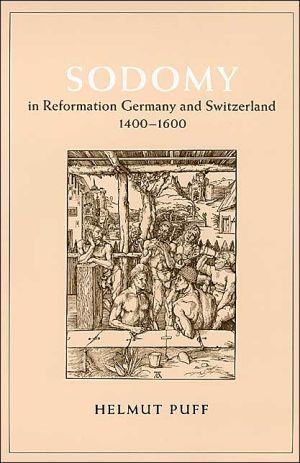Sodomy in Reformation Germany and Switzerland, 1400-1600
During the late Middle Ages, a considerable number of men in Germany and Switzerland were executed for committing sodomy. Even in the seventeenth century, simply speaking of the act was cause for censorship. Here, in the first history of sodomy in these countries, Helmut Puff argues that accusations of sodomy during this era were actually crucial to the success of the Protestant Reformation. Drawing on both literary and historical evidence, Puff shows that speakers of German associated sodomy...
Search in google:
During the late Middle Ages, a considerable number of men in Germany and Switzerland were executed for committing sodomy. Even in the seventeenth century, simply speaking of the act was cause for censorship. Here, in the first history of sodomy in these countries, Helmut Puff argues that accusations of sodomy during this era were actually crucial to the success of the Protestant Reformation. Drawing on both literary and historical evidence, Puff shows that speakers of German associated sodomy with Italy and, increasingly, Catholicism. As the Reformation gained momentum, the formerly unspeakable crime of sodomy gained a voice, as Martin Luther and others deployed accusations of sodomy to discredit the upper ranks of the Church and to create a sense of community among Protestant believers. During the sixteenth century, reactions against this defamatory rhetoric, and fear that mere mention of sodomy would incite sinful acts, combined to repress even court cases of sodomy.Written with precision and meticulously researched, this revealing study will interest historians of gender, sexuality, and religion, as well as scholars of medieval and early modern history and culture.
Sodomy in Reformation Germany and Switzerland, 1400-1600 \ \ By HELMUT PUFF \ The University of Chicago Press \ Copyright © 2003 The University of Chicago\ All right reserved.\ ISBN: 978-0-226-68506-9 \ \ \ \ \ Chapter One \ The Politics of Sodomy (1277-1532) \ In 1277 the German King Rudolf I of Habsburg (1218-91) sentenced a certain dominus de Haspisperch to be burned at the stake. According to a contemporary Dominican chronicle from Basel, the noble (dominus) had committed the "sodomitical vice." This may well be the earliest document of an execution for the vicium sodomiticum in the German empire. The chronicle's sparse record leaves many questions unanswered-most pressingly, which sexual transgression the dominus had to die for. What the chronicle documents, however, is significant enough to attract attention: When sitting in judgment, a newly elected king punished a sexual act that, whatever had occurred, met with the most severe reprobation among the age's leading theologians. A contemporary Dominican chronicler from a monastery with close ties to the king recorded this sentence, meted out by a secular ruler, through language that deployed the age's scholastic theology.\ In the later Middle Ages, same-sex sexual behavior came under the purview of secular jurisdiction. On a case-by-case basis, judicial authorities in late medieval Europe developed an unambiguous and lethal tactic against the vicium sodomiticum, understood here as male-male sodomy. Kings, princes, prelates, and city councilors-all of them acting as judges-saw the criminal prosecution of same-sex relations, predominantly among men, as an age-old prerogative. Yet such prosecution became a regular feature of criminal proceedings only in the later Middle Ages, at a time when the authorities widened their understanding of what was deemed criminal and increased their efforts to punish offenders.\ Around the time of Haspisperch's execution, concerns about same-sex sexual behavior intensified. When Thomas Aquinas (1224/25-75) worked previous references to sodomia into a more systematic treatment in his Summa theologiae, the "vice against nature" comprised a number of sexual acts all said to resist Nature's call for procreation (e.g., masturbation, bestiality), while vitium sodomiticum-the term used in the chronicle entry-was reserved for same-sex acts. Increasingly, theological writings were not the only ones featuring references to same-sex behavior. German poetry and legal texts followed suit. By the mid-thirteenth century, literary innovators composed didactic verses in the vernacular, condemning the "damned heresy" (verwâzen ketzerîe) when men turn to men instead of women for minne (love). The most widely disseminated vernacular law code in south Germany, the Schwabenspiegel (c. 1275/76), compiled in an Augsburg monastery, calls those people traitors "who defame somebody by their speech" (die mit ir rede einen verpalmundent). Whether detractors vilify a person as "a sodomite" (ein sodomite), as having "committed sex with animals" (er habe vihe geunreinet) or as a "heretic" (kezzer), they ought to be broken on the wheel. An Augsburg law code of 1276-a text inspired by the Schwabenspiegel-introduces distinctions among different kinds of "heresy." The city's lawmakers prescribed that a religious heretic (ein chetzer umbe ungelauben) ought to be transferred to the clergy (and, if found guilty, executed by the vogt), while a heretic of a secular kind should be taken to the urban court. In both cases, the crimes were considered to be acts against Christianity, and both "heresies" resulted in the same punishment, burning at the stake. A Bavarian law code of 1328 elucidates the nature of "secular" heresy as mentioned in Augsburg in 1276. Ruprecht of Freising lists two kinds of sexual transgressors under the heading "heretic," a maendlaer and his sexual partner-both ought to be burned-as well as those who pollute themselves with animals (vichunrainer). Practitioners of the law thus differentiated what heresiologists had successfully linked for generations-sexual deviance and religious unorthodoxy.\ The figure of the heretic never shed its manifold religious associations even when a more narrowly defined sexual heresy was prosecuted by secular institutions. Heresy-whose German version, ketzerie, derives etymologically from the sect of the Cathars-continued to evoke an uneven terrain, positioned between Latin and the vernacular, religious dogma and civic codes of behavior. Heresy thus concerned individuals as well as communities. It conjured up powerful notions of sexual as well as religious purity. And its most common punishment, burning at the stake, held Biblical associations that connected the fate of Sodom with that of imperial cities.\ * * *\ This chapter seeks to uncover when and how sodomy came to be prosecuted as a crime in the German empire. Why did judges act so severely in cases of sodomy? What do the written records and the wording of the documents betray about the origins of civic concerns over same-sex sexual behavior? It is my claim that the increasing attention given to sodomy can be understood only in terms of the infusion of secular politics with religious ideas, though many cities pursued their own agenda in persecuting sexual "heretics." I will trace judicial responses to same-sex sexual behavior until 1532, when the Constitutio Criminalis Carolina, the first imperial law code, mandated burning at the stake for "heretical" sexual acts between men and between women. As the chapter unfolds, I will present fragments of past lives and past sexualities that, for the most part, historiography on Germany and Switzerland has tended to ignore.\ State Formation and Sexual Discipline in the Late Middle Ages\ The state that in the fifteenth century became known as the Holy Roman Empire of the German Nation encompassed lands much vaster than what is now Germany. It stretched from the Low Countries to Tyrolia and Italy, from Lorraine to Bohemia. The claim to preeminence expressed in its ceremonious title contrasted with a political reality much less glorious. Cohesion between regions different in language, economic output, and level of urbanization was low. These lands were nominally subject to one ruler, the emperor. Yet few imperial agencies existed apart from the feudal obligations, leagues, and corporations which made up the essence of this kaleidoscopic political entity in the midst of Europe.\ The Swiss Confederacy, though formally a member of the polity, ceased to participate in imperial affairs in the fifteenth century. When Emperor Maximilian I (1459-1519) tried to enforce the Confederacy's allegiance militarily in 1499, the confederates were victorious over an imperial army and remained de facto independent. De iure independence followed only with the peace of Westphalia in 1648.\ With its loose political structure, the Holy Roman Empire of the German Nation often does not get good press. Yet the fifteenth century went down in the annals as a period of great reforms for the imperial body politic. In order to alleviate conflicts, various estates rallied under the banner of peace. Constitutional change even provided the empire with something of a metastructure. The diets, irregular meetings of the imperial estates under the guidance of the emperor, developed into a political body whose composition was more stable than ever before. Institutions like the Imperial Chamber Court (Reichskammergericht), first instituted in 1495 as a high court (and after 1498 complemented by the Reichhofsrat), or the military districts (Reichskreise), agreements like the Eternal Public Peace (Ewiger Reichslandfriede of 1495), as well as preparations for a general law code (which, ultimately, would include an article on sodomy and bestiality) seemed to herald even grander reforms to come. The reforms never came to full fruition, despite overblown rhetoric for the empire among humanists. Centrifugal political forces undermined an ever-fragile consensus, while confessional strife after the onset of the various Reformations would make agreements ever more difficult to achieve.\ Scholars rightly insist that the German lands remained rural in character throughout the medieval and early modern periods. Indeed, in urbanization the empire lagged behind Italy, the most urbanized society in Europe at the time. Yet the German cities which harbored diets were thriving centers of political and economic power, even though the same communities were politically underrepresented at these gatherings. Places such as Nuremberg, Augsburg, Ulm, and Strasbourg accumulated unprecedented levels of wealth in the fifteenth century. The rise of urban trading centers also had an impact on the character of politics in this period. Medieval and early modern cities inaugurated the transformation of the communal body politic into a statelike entity characterized by both freedom and discipline. The freedom of German towns was proverbial, though freedom signified something different from individual rights. Above all, the status of a free city meant its right to rule the urban territory without interference from powers other than the king. Traditionally, decision-making resided in a city's assembly of free burghers ruled by councilors who also acted as judges. Though the tradition of cities as assemblies bound by the oath of individuals (Schwurgemeinschaft) never died, a city council's exercise of power and its juridical grip on its subjects greatly intensified during the period under consideration.\ In an age of increasing social stratification, many forces set out to limit strife and foster a sense of commonality. As Heiko A. Oberman states, there was "a new awareness of all men being equal under the just will of God, which is seen as equally binding, embracing, and obligatory for the entire society, city and country, peasants and city folk, ecclesiastical and civil authorities." According to this understanding, all citizens were jointly bound to maintain order, a concept closely tied to the divine will, Nature's rules (in the medieval sense of nature as God's creation), and political order. At least in intent, urban politics was universalized and, by individual measures, extended to all inhabitants, including the clergy, for instance. Increasingly, efforts were made to forge a more coherent body politic. Whereas the territorial expansion of cities met the resistance of neighboring powers, inward expansion knew few bounds. Criminal offenses were the appropriate place to test the juridical, moral, and political strength gained by the centers of urban power in their striving for independence from the princes and bishops.\ Since the High Middle Ages, city charters had invested communities with privileges, including the right to punish criminal offenders. In many communities, however, criminal prosecution of sodomy and other delicts required the presence of a feudal lord or his representative well into the fifteenth century. Yet urban communities strove to increase autonomy in legal affairs, at the same time as new urban elites superseded the old rule of nobles in many cities. In an attempt to rid themselves of the rights of overlords or bishops, urban regimes extended their authority in criminal matters. Increasingly, they sat in judgment even on capital offenders (which had been reserved to the lords in earlier times).\ Why did secular courts and urban communities start to persecute sodomites in the late Middle Ages? To answer this question, we have to leave behind urban politics and turn to the history of religious dogma, two spheres that corresponded in medieval times. It has long been acknowledged that the eleventh and twelfth centuries marked a watershed in Latin Christendom's attitudes toward same-sex eroticism. In his groundbreaking Christianity, Social Tolerance, and Homosexuality, John Boswell detected a lack of interest in homosexual behavior before the scholastic age. According to Boswell, neither "Christian society nor Christian theology as a whole evinced or supported any particular hostility to homosexuality." Though sodomy was not condoned as a sexual practice, same-sex eroticism seems to have been of relatively little concern to theologians in the early Middle Ages. Critics have shown that Boswell underestimated the handbooks of penance, manuals of tariffs for sins in which same-sex acts were regularly mentioned. Yet, even in light of these handbooks (whose relevance for interactions between priests and believers is a matter of dispute), one can still uphold the assessment of the Church's relative lack of interest in homosexual behavior, at least if one does not misinterpret lack of interest as signifying tolerance.\ In approximately the year 1050, one of the foremost proponents of Church reform as well as a brilliant rhetorician, Peter Damian (c. 1005-70), attempted to purge ecclesiastical institutions, especially monasteries, of sexual and other "impurities." His Liber Gomorrhianus, a treatise in the form of a letter addressed to Pope Leo IX (1049-54), was part of a campaign to enforce Rome's superiority over the ranks of the Church. Unlike his attack on simonists, Damian's doctrinally inspired tirades against masturbators and sodomites found few followers among his contemporaries in the eleventh century. This lack of resonance notwithstanding, the Liber Gomorrhianus set the tone for condemnations of sodomy among later generations of theologians. From the twelfth century onward, scholasticism and its rational theology created a new intellectual climate and a body of knowledge that reigned supreme in the following centuries. Scholastics introduced a dogma which castigated sodomitical transgressors severely. Theologians such as Peter Cantor (d. 1197), Albert the Great (1200-1280), and Thomas Aquinas singled out this sexual sin as one of the worst violations of the divine order and, except for bestiality, the worst among all sexual sins.\ The emergence of Catholic doctrine on sodomy and "the formation" of Western Christendom's "persecuting society" stimulated novel forms of sanctions across Europe, a "machinery of persecution" in the words of Robert Ian Moore. In the course of the twelfth century, ecclesiastical councils as well as secular rulers enacted laws that, for the first time in medieval Europe, stipulated severe penalties for sodomy. Though there is little evidence that these precepts were implemented, the fact that they were formulated is significant in and of itself. Legal norms and precedents created stimuli to penalize same-sex offenders. In the long run, trials and executions became occasions to legitimize rule by purging communities of sexual offenders. But if we start to hear about sodomy trials in the German empire in the thirteenth century, this is also because of the extended use of writing in civic administrations. In archives, acts of rulership such as the prosecution of criminals were documented. Novel methods of record keeping alone do not explain why persecution became evident during the High Middle Ages. Both the prosecution of criminals and the emergence of civic bureaucracies testify to an expansive vision of rule. Towns in the well-populated and highly urbanized region between Germany's central mountains and the Alps (what is now south Germany and the German-speaking part of Switzerland) pioneered the development of models of civic administration as well as the penalizing of same-sex sexual behavior among men.\ (Continues...)\ \ \ \ \ Excerpted from Sodomy in Reformation Germany and Switzerland, 1400-1600 by HELMUT PUFF Copyright © 2003 by The University of Chicago. Excerpted by permission.\ All rights reserved. No part of this excerpt may be reproduced or reprinted without permission in writing from the publisher.\ Excerpts are provided by Dial-A-Book Inc. solely for the personal use of visitors to this web site. \ \
AcknowledgmentsIntroduction11The Politics of Sodomy (1277-1532)172Cases, Conflicts, Contexts313The Discourse of Experts504Acts without Words, Acts of Silencing: The Sixteenth Century755Defamation as Practice1076The Art of Defamation: Humanists and Reformers1247Sodomy in the Reformation Pamphlet1408The Close Encounter of Matrimony and Sodomy167Conclusion179Appendix183Notes191Bibliography267Index303








